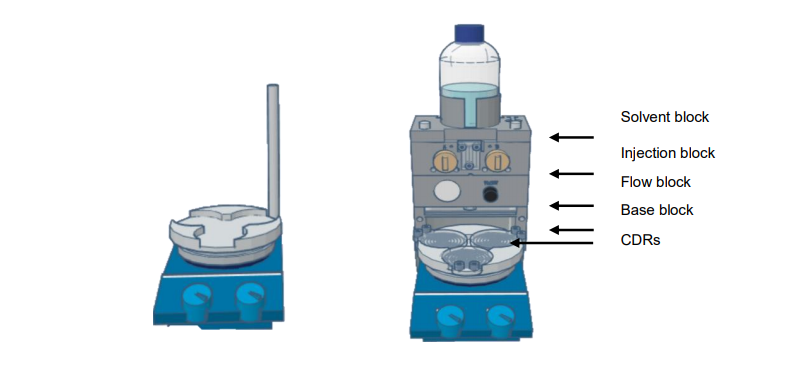 Researchers for the UCL School of Pharmacy are delving further into the use of 3D printing and continuous flow systems with a recent published paper, ‘Modular 3D Printed Compressed Air Driven Continuous-Flow Systems for Chemical Synthesis.’ Authors Matthew R. Penny, Zenobia X. Rao, Bruno Felicio Peniche, and Stephen T. Hilton explain how 3D printing allows chemists to streamline processes as needed in chemistry, especially with modular units.
Researchers for the UCL School of Pharmacy are delving further into the use of 3D printing and continuous flow systems with a recent published paper, ‘Modular 3D Printed Compressed Air Driven Continuous-Flow Systems for Chemical Synthesis.’ Authors Matthew R. Penny, Zenobia X. Rao, Bruno Felicio Peniche, and Stephen T. Hilton explain how 3D printing allows chemists to streamline processes as needed in chemistry, especially with modular units.
The authors point out that both 3D printing and continuous-flow chemistry have been on parallel paths as emerging technologies, intersecting as scientists realize the benefits of being able to create parts as needed, or replace them as needed in the lab. They also state that the average 3D printer used in a chemistry lab is affordable at around $3,000 and allows them to experiment with numerous materials and fabricate what they need.
Previously, this group of researchers has been involved in 3D printing reactors with polypropylene that can be easily connected to existing systems. One of the challenges though has been the prohibitive cost of flow reactor systems, at $20,000 or more, making it difficult for many chemists to attain them. Such technology can be invaluable, however, and the chemists began investigating a way to 3D print entire continuous flow systems.

A) Stirrer hotplate with DrySyn Muti-E base; B) Planned System attached to stirrer hotplate
incorporating three circular disk reactors.
“In addition, we wanted a system with a small size footprint that could be integrated with existing laboratory equipment and removed and stored when not needed, stopping the typical blocking of fume cupboards encountered with most continuous flow systems,” said the research team.
They used the DrySyn Multi-E base for adjusting the flow path of the reactor and were able to 3D print circular disk reactors (CDRs) to be put into the base, with more reactors added as needed. Tinkercad was used as the modeling software for the reactors, with screw-thread adaptors also created for PEEK fittings. An Ultimaker 3D printer was then used, with PP filament, operating at 100 percent infill with an internal volume of 4.2 ml. In line with the need for affordability, they avoided the use of costly pumps and instead used compressed air for their systems; in dry conditions, air could easily be replaced with nitrogen gas.

A) Graphical CAD representation of DrySyn Multi-E base; B) Graphical CAD design of DrySyn
Multi-E base and three CDRs; C) Part printed CDR showing the flow path; D) Fully PP printed CDR; E)
Installed CDRs and linking for a longer flow path.
“The system was composed of a base unit housing the compressed air manifold, a flow control unit containing a needle valve for fine control of the pressure for reactor flow and an injection unit where reagents could be readily added into the flow path via low-pressure 6-position loop injectors,” said the research team. “All blocks were designed to be the same size to fit above the stirrer hotplate and the larger solvent holder was placed directly above these and the blocks held down by the metal hotplate rods.”

A) Selected capillaries showing the lengths required to provide flow rates ranging from
8mL/min to 0.1 mL/min.
The researchers noted that with the initial setup, they were not able to gain the exact control desired over the system. Deriving inspiration from capillary resistors being used today in microfluidics, they gained greater control by altering the pressure according to Hagen-Poiseuille law, and using five capillaries that would cover a flow rate range of 0.1-8 mL/min.
“Pleasingly, when these capillary resistors were tested with our system, we observed excellent control of the flow rate which matched the predicted controls,” stated the researchers.
After establishing control of the reactors, the team began looking for a way to show off the system’s functionality and utility through reactions, optimized with the 3D printed FlowSyn reactor system, embellished with capillary tubes for a variety of flow rates and temperatures. They were pleased with the reactions and flow rates. Following that, the researchers also screened a range of alcohols that helped form a variety of derivatives and compounds also.
“This approach will enable synthetic chemists to carry to flow chemistry at low-cost and using existing laboratory and fume hood equipment without having to invest in expensive and large continuous flow equipment. Further studies on additional reactors and reaction chemistries are currently under way in our laboratory and will be reported in due course,” conclude the researchers.
Since its inception, 3D printing has been connected to the world of chemistry. The progressive technology fits naturally into the science, along with the entire STEM (science, technology, engineering, mathematics) realm. While even the creation of wearables and microfluidic devices are dependent on the pairing of 3D printing and chemistry, other advancements are being made in continuous flow too as parts can be created to fit whatever needs scientists may need for a particular project—and with 3D printing, innovation allows for parts, components, processes, and mechanisms that simply were not possible before with more conventional methods of manufacturing, from the smallest to the largest projects.
What do you think of this news? Join the discussion of this and other 3D printing topics at 3DPrintBoard.com.

A) Disassembled CAD drawing outlines of the separate continuous flow system components
covering the solvent block, injection block, CDRs, mixing chip, flow controller and base block; B) 3Dprinted and realised hotplate continuous flow-system combined with circular disk reactors.
Subscribe to Our Email Newsletter
Stay up-to-date on all the latest news from the 3D printing industry and receive information and offers from third party vendors.
You May Also Like
Game-Changing $115M for Aspect Biosystems’ Bioprinted Tech
Pioneering solutions for metabolic and endocrine diseases, Vancouver-based Aspect Biosystems raised $115 million in Series B funding to advance its bioprinted tissue technology. Led by investment firm Dimension, the round...
From Lab to Lifeline: Anthony Atala’s Vision for Bioprinting at WFIRM
Anthony Atala is transforming the future of medicine—not just with a scalpel, but with a bioprinter. As the director of the Wake Forest Institute for Regenerative Medicine (WFIRM), he’s pushing...
NSF-Backed $2.5M Grant Boosts Bioprinting Innovation in North Carolina
Fueled by a $2.5 million grant program, a handful of companies in North Carolina are using bioprinting to take on big challenges in regenerative medicine. The funding supports projects addressing...
3D Printing Webinar and Event Roundup: December 8, 2024
This week, we’ve got a number of webinars, on topics from 3D printing software and medical applications to printed electronics, PVC for industrial 3D printing, and more. There are also...




























